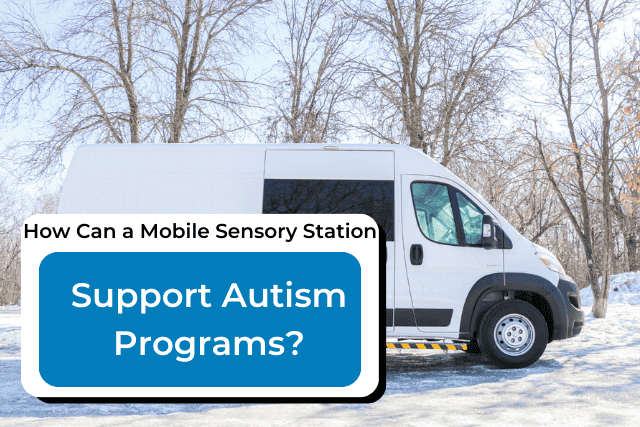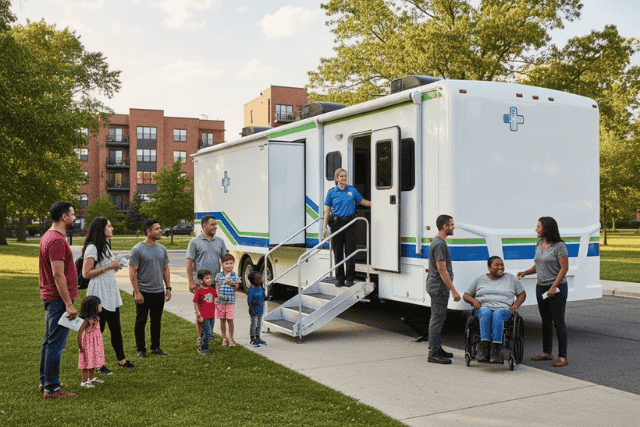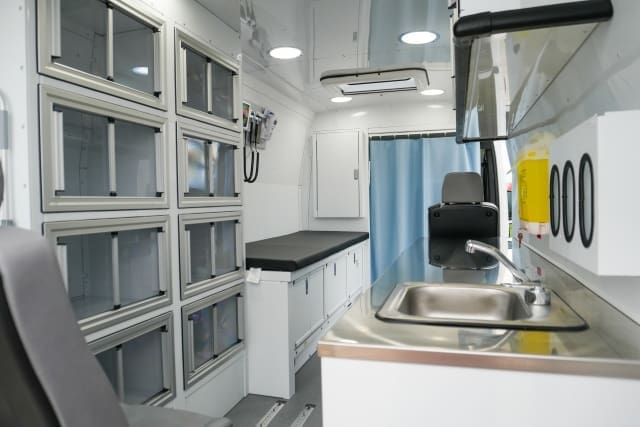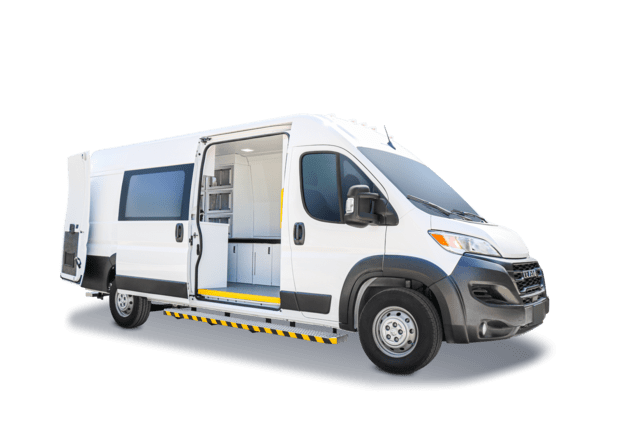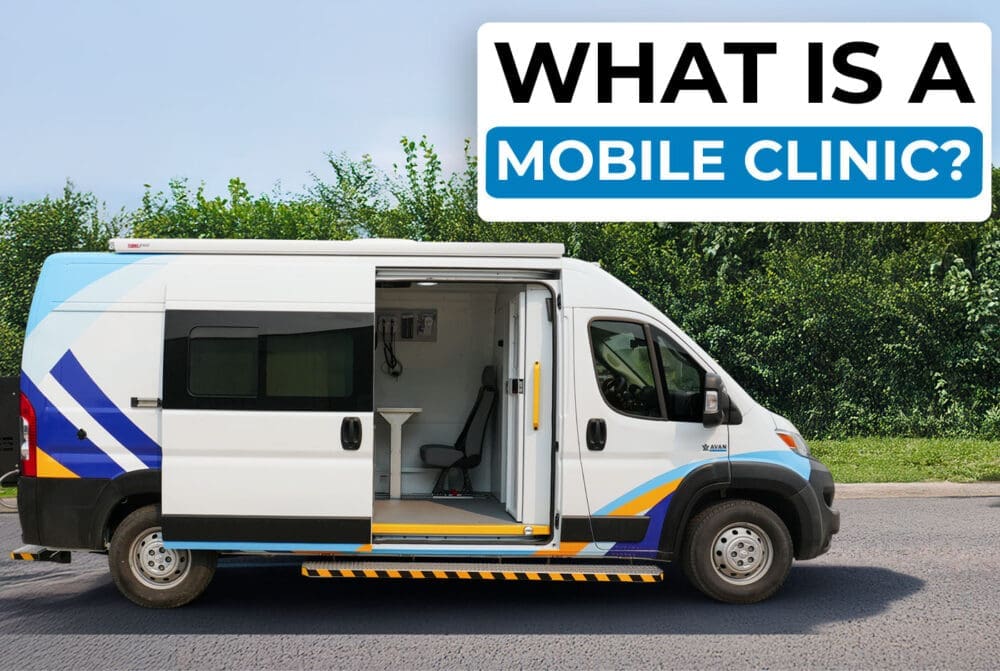Did you know that 1 in 36 kids in the U.S. has autism? That means millions of families are trying to find the right support, but not everyone has easy access to the services they need.
Some families live too far from therapy centers. Others can’t get there because of transportation issues. And for some kids, busy clinics with bright lights and loud noises can be overwhelming. When these challenges get in the way, kids miss out on important care. That can lead to more stress, fewer learning opportunities, and a harder time developing the skills they need to thrive.
Now, imagine a different solution. What if the therapy came to them? A mobile sensory station is like a therapy room on wheels. It brings a calm, supportive space straight to kids and adults with autism, wherever they are. No more long trips or overwhelming settings, just the care and support they need, right in their own community.
At AVAN Mobility, we build custom mobile medical units that help remove barriers to healthcare and transportation. We’ve worked with organizations across the U.S. to develop solutions that save lives and improve accessibility. From mobile clinics to wheelchair-accessible vans, our focus has always been on helping people who help people.
In this article, we’ll cover:
- What a mobile sensory station is
- How it helps autism programs
- The key benefits for families and providers
What is a mobile sensory station?
Imagine being in a place that feels too bright, too noisy, or just too much. For many people with autism, everyday places, like a school cafeteria, a busy doctor’s office, or a loud store, can feel overwhelming. Certain lights, sounds, or even textures can be hard to handle, making it difficult to focus, communicate, or feel calm.
A mobile sensory station helps with that. It’s a specially designed vehicle that creates a quiet, safe space where people can relax, reset, and get the support they need. These units can be used for therapy, calming activities, or just a break from stressful environments.
Inside, a mobile sensory unit might have:
- Soft lighting and soundproofing to block out distractions
- Weighted blankets, fidget tools, and textured walls to help with focus
- Bubble tubes, fiber optic lights, or interactive panels to provide sensory stimulation
- Quiet corners where someone can take a break and feel safe.
These spaces can be built inside different types of vehicles, depending on what an organization needs.
Some options include:
- Vans: Easy to drive and perfect for small sensory spaces
- RVs: Spacious area for therapy and group activities
- Trailers: Can be parked at schools or events for on-site support
A mobile sensory unit makes it easier to bring sensory support directly to those who need it, no matter where they are.
How can mobile sensory stations help your autism program?
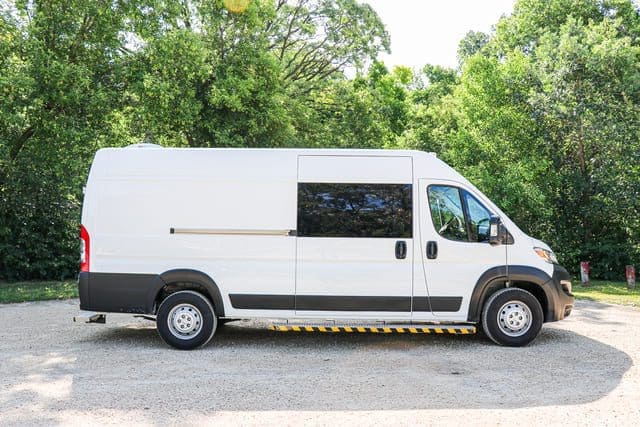
Getting autism support isn’t easy for everyone. In big cities, there are plenty of therapy centers, but in small towns and rural areas, there might be no autism services in sight for hours. More than 60 million people in the U.S. live in rural communities, and many families in these areas struggle to get the therapy and sensory support their kids need.
Even in the suburbs, access isn’t always simple. Some families don’t have a vehicle, and others simply can’t take time off work to drive to appointments. For kids who get overwhelmed easily, busy therapy centers can feel stressful instead of helpful. That means a lot of kids miss out on services that could really help them.
This is where a mobile sensory station makes a difference. Instead of families coming to a center, the support comes to them. Because these units are mobile, they can:
- Reach small towns and rural areas that don’t have autism services nearby
- Provide a quiet space at schools or community events for kids who need a break
- Make therapy more flexible for families who can’t always make in-person appointments
- Help autism programs serve more people without needing more buildings
What are the benefits of mobile sensory stations for families?
If your organization runs an autism therapy program, you already know how tough it can be for families to get the right support. Even in big cities, you might deal with long waitlists, packed schedules, or the challenge of getting children to and from appointments. It’s frustrating, and you know the families need help, but sometimes, figuring out how to provide it feels impossible.
As you now know, your mobile sensory station can make things easier for families by bringing sensory-friendly spaces and therapy right to them, no matter where they live.
Here’s why that matters:
No more long, stressful drives: Not every family has a reliable car or the ability to take time off work for therapy sessions. A mobile sensory unit comes to them, cutting down on missed appointments and last-minute cancellations.
Help for families in small towns: In places where autism services are hard to find, a mobile sensory unit can park at schools, community centers, or even local clinics so kids don’t miss out on support.
A quiet space when things get overwhelming: Children with autism tend to get overstimulated in certain environments. You can set up a mobile sensory unit in public places, giving kids a space to calm down when they need it.
More consistent therapy: Children with autism do best with routine and regular support. If services aren’t easy to access, progress can stall. Mobile sensory units fill the gap, making sure kids get the care they need when they need it.
What should you consider when choosing a mobile sensory station?
Not all mobile sensory stations are the same. Before choosing one, think about where and how you’ll be using it. Will you be driving to extremely rural areas with rough roads and long distances between stops? Or will you be navigating tight city streets and squeezing into small parking spaces? The right mobile sensory unit depends on what works best for your program.
Here are some things to consider:
Where you’ll be driving: If you’ll be on gravel roads that twist and turn or rough winter conditions, a smaller-chassis vehicle like a van is often easier to handle. Check out our article on the Trail Edition to learn more about that. If the most space possible is your priority and you’ll mostly be parked in one spot, a larger RV or trailer-style mobile sensory station might work well.
Who you’ll be helping: Will you serve large groups of students or offer one-on-one sessions? Bigger schools and community centers may need a larger sensory space, while smaller programs will benefit from the personalized and private feel of a compact unit.
What sensory tools you need: Do you want a quiet room for de-escalation or a fully interactive space with sensory walls and lights? The setup should match the needs of the people you serve.
Climate control: Will you be using your mobile sensory unit in places with harsh winters or extreme heat? Proper heating, air conditioning, and insulation in your mobile sensory unit make a big difference.
Choosing the right mobile sensory station comes down to who, where, and how you’ll be helping people. Thinking through these details now will help you get the best fit for your program.
Interested in learning more about mobile sensory units?
Getting autism support shouldn’t be so complicated. But for many families, long drives, full waitlists, and overstimulating environments make it difficult to access the right care. That’s why you’re here, looking for a way to bring sensory-friendly spaces directly to those who need them.
Now, you have a better understanding of:
- What a mobile sensory station is and how it supports autism programs
- How it removes barriers and makes therapy more accessible
- Key factors to consider when choosing the right setup for your organization
At AVAN Mobility, we design custom mobile medical units that help organizations like yours expand their reach. Our team works closely with healthcare organizations, schools, and community centers to create mobile medical vehicles that fit their unique needs.
Let’s talk about your program’s needs. Click the button below to connect with a mobility expert.
Not quite ready? No problem. We have a few other resources for you to check out to learn more.
Start by reading our article on securing grants for your mobile medical unit. This will steer you in the right direction if you’re struggling to find funding.
After that, check out our article on mobile office space. This is something you’ll likely need in a mobile sensory unit.
